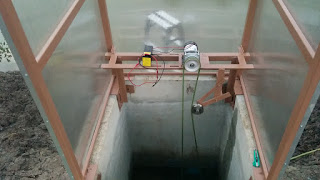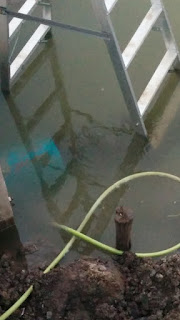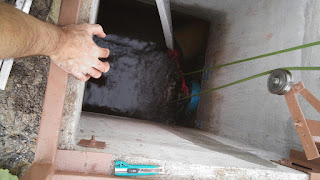I’ve been busy with quite a few things recently, both at work and on the land. The land stuff has been mostly incremental steps that didn’t really warrant posting here.
But I was very excited today to get the chance to test the pond circulation pump in its actual installation configuration. The rainy season has dumped quite a bit of water, and the water level is finally a few centimeters over the pump, so that the pump can now operate as intended. (The rainiest day we observed was about a week ago. The water level rose in the pond by about 10cm in a 24 hour period.)
The motor we chose to use is a 24V DC geared motor. We’ve attached it to a welded metal platform on top of the cement cistern, and then are using a basic rubber vee belt to drive the pulley connected to the impeller that sits inside the water.
Here is a photo of it in operation connected to a 12V battery:
On a cool side note, we are almost done building a metal frame + polycarbonate walled shack to protect the electrical stuff from the rain. I would like to add bamboo sheets to the outside to give it a more natural look.
On the other side of the cement cistern is the 12″ PVC outlet which the impeller pushes the water out of. In this photo, if you look very closely, you can see the ripples showing the water motion:
You can ignore the green tube. That is part of the air pump configuration which is being set up in the same area.
I also put my hand in the water at the outlet and felt that the water was actually flowing out at a fairly constant rate. I would estimate that it is flowing at a nice smooth rate of about 20cm per second. (At 12V, the impeller is only rotating about 50-100RPM, so this is in line with expectation.)
The idea behind the pump is that the water should flow into the cistern from a large pipe whose inlet is in the sand filtration area about 40 meters away, and then the circulation pump moves the water back into the clear water area, in order to have it naturally circulate back to the sand filtration again. So even though I confirmed that the water was coming out in the right place, I still needed to confirm that the water was coming into the cistern through the correct pipe. In other words, I needed to make sure the water wasn’t flowing back in from the same place I was pumping it out to. The idea Praew came up with was to stick a piece of cloth into the water on the end of a stick and see how it moves. Kind of like an underwater flag blowing in the wind (i.e. current).
Here is one last photo:
At this point, it was almost dark, so the stuff in the water is hard to see clearly. But if you look carefully, you can see the inlet pipe in the upper right, and the pump outlet pipe on the middle right. The white strip at the top is a scrap piece of polycarbonate, and the red cloth tied at the end is visible in the water. Every time I lowered the cloth into the water near the inlet pipe, it immediately started “blowing” towards the outlet pipe. This seems to confirm that the water is actually flowing in the correct way.
Finally, I measured the electrical current draw of the motor and it came out to 4.5A. At 12V, this comes out to 54W. If I use my estimate of 20cm per second flow rate, and a cross sectional area of the 12″ PVC at 0.073 sqr meters, this comes out to about 15L/sec flow rate. At 54W, this is about 270 liters per second per kW of electricity. In this previous post, I tested two other commercially available pumps. In comparison to the “pump payanak”, this is 12.5x more efficient, and compared to the 200W aquarium pump, it is 27x more efficient.
So for now, I would call this a complete success.
The last hurdle is that the sand isn’t fully washed and laid down, so there is the possibility that this affects performance, but I am hoping not. This was the whole reason we laid down almost a meter of gravel over the inlet holes, in order to make sure that the water can easily flow into the inlet pipe after passing through the sand. In a week or two, this will be the last test.


